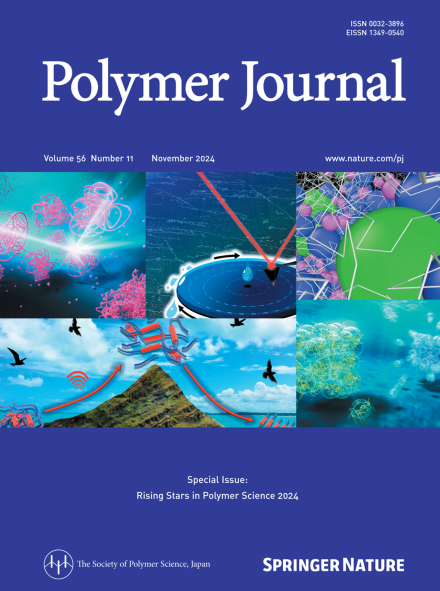Design of functional and stable adhesion systems using reversible and movable crosslinked materials
IF 2.7
4区 化学
Q3 POLYMER SCIENCE
引用次数: 0
Abstract
Stable, tough, and functional adhesion systems are urgently needed for a sustainable society. As a resolution, supramolecular scientists have introduced reversible and movable crosslinked materials into adhesion systems. Reversible crosslinks can repeatedly associate and dissociate. Therefore, reversible crosslinked materials show self-healing and stimuli-responsive properties. Moreover, movable crosslinks are topological crosslinks in which the polymer chains penetrate the cavities of cyclic molecules. The sliding of the movable crosslinks with deformation enabled the achievement of materials showing high toughness and self-relaxation. Adhesion systems with reversible and movable crosslinks have improved adhesion and cohesion, stability, and functionality. This novel concept for the design of adhesion systems is expected to increase the lifetime of adhesives and ameliorate environmental problems. This review paper summarizes various works on supramolecular materials with reversible and movable crosslinks and their application as adhesives. Reversible crosslinks can repeatedly associate and dissociate. Therefore, The reversible crosslinked materials show self-healing and stimuli-responsive properties. The slide of the movable crosslinks with deformation resulted in high toughness and self-relaxing of the materials. The adhesion systems with reversible and movable crosslinks show improved adhesion and cohesion properties, stability, and functionality. This new concept for designing adhesion systems is expected to enhance the lifetime of adhesives and reduce environmental problems.

利用可逆和可移动交联材料设计功能性稳定粘合系统
可持续发展社会迫切需要稳定、坚韧、功能强大的粘合系统。为解决这一问题,超分子科学家们在粘合系统中引入了可逆和可移动的交联材料。可逆交联可以反复结合和解离。因此,可逆交联材料具有自愈和刺激响应特性。此外,可动交联是拓扑交联,其中聚合物链穿透环状分子的空腔。可动交联随着变形而滑动,从而使材料具有高韧性和自松弛性。具有可逆和可动交联的粘合系统提高了粘合力和内聚力、稳定性和功能性。这种设计粘合系统的新概念有望延长粘合剂的使用寿命并改善环境问题。本文综述了有关具有可逆交联和可动交联的超分子材料及其作为粘合剂应用的各种研究成果。可逆交联可以反复结合和解离。因此,可逆交联材料具有自愈合和刺激响应特性。可移动交联体随着变形而滑动,从而使材料具有高韧性和自松弛性。具有可逆和可动交联的粘附系统显示出更好的粘附和内聚性能、稳定性和功能性。这种设计粘合系统的新概念有望提高粘合剂的使用寿命,减少环境问题。
本文章由计算机程序翻译,如有差异,请以英文原文为准。
求助全文
约1分钟内获得全文
求助全文
来源期刊

Polymer Journal
化学-高分子科学
CiteScore
5.60
自引率
7.10%
发文量
131
审稿时长
2.5 months
期刊介绍:
Polymer Journal promotes research from all aspects of polymer science from anywhere in the world and aims to provide an integrated platform for scientific communication that assists the advancement of polymer science and related fields. The journal publishes Original Articles, Notes, Short Communications and Reviews.
Subject areas and topics of particular interest within the journal''s scope include, but are not limited to, those listed below:
Polymer synthesis and reactions
Polymer structures
Physical properties of polymers
Polymer surface and interfaces
Functional polymers
Supramolecular polymers
Self-assembled materials
Biopolymers and bio-related polymer materials
Polymer engineering.
 求助内容:
求助内容: 应助结果提醒方式:
应助结果提醒方式:


